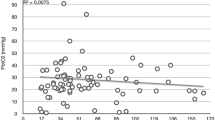Summary.
Background: Cerebral ischemia is considered a key factor in the development of secondary damage after Traumatic Brain Injury (TBI). Studies on Cerebral Blood Flow (CBF) have documented decreased flow in over 50% of patients with TBI, studied in the acute phase. Transcranial Doppler (TCD) sonography is a non-invasive technique, permitting frequent or continuous measurements of blood flow velocity in the basal cerebral arteries.
Objectives: To investigate the potential of TCD to detect decreased blood flow velocity in the early phase after TBI;
To investigate whether flow velocity differs between hemispheres in patients with focal lesions versus those with more diffuse injuries;
To investigate if decreased blood flow velocity is indicative of cerebral ischemia, as evidenced by measurements of brain tissue pO2.
Methods: TCD examinations were performed in 57 patients with severe TBI (GCS≤8) daily over a period of 10 days, with particular attention focused on the first 72 hours, during which period examinations were performed more frequently. A low flow velocity state (LFVS) was defined as a flow velocity≤35 cm/sec in one or both MCA's within 72 hours after trauma. PbrO2 was measured in 33 patients with an intraparenchymal Clark type electrode (Licox).
Patients were differentiated into those with primarily unilateral pathology on the admission CT scan versus those with primarily more diffuse or bilateral pathology. Outcome was evaluated at six months after injury, according to the Glasgow Outcome Scale (GOS).
Results: A low flow velocity state was observed in 63% of patients studied. Decreased flow was most pronounced during the first eight hours after injury and was accompanied by high pulsatility indices, especially at the side of the lesion. Flow velocity increased significantly after this time period. Initial Vmca values had a strong correlation with ipsilateral measured PbrO2 values (R=0.73). The occurrence of a LFVS was associated with poorer outcome (odds ratio 3.9).
Conclusions: TCD studies show reduction of cerebral blood flow velocity in the acute phase after traumatic brain injury. Decreased flow velocity is most pronounced ipsilateral to focal pathology. A low flow velocity state is probably due to high peripheral resistance, and is indicative of ischemia, as demonstrated by the association with decreased PbrO2. A low flow velocity state is of prognostic value and identifies patients at increased risk for ischemia. Early TCD studies are recommended in TBI.
Similar content being viewed by others
Author information
Authors and Affiliations
Additional information
Published online October 31, 2002
Correspondence: Andrew I. R. Maas, Department of Neurosurgery, Erasmus MC, Dr. Molewaterplein 40, 3015 GD Rotterdam, The Netherlands.
Rights and permissions
About this article
Cite this article
van Santbrink, H., Schouten, J., Steyerberg, E. et al. Serial Transcranial Doppler Measurements in Traumatic Brain Injury with Special Focus on the Early Posttraumatic Period. Acta Neurochir (Wien) 144, 1141–1149 (2002). https://doi.org/10.1007/s00701-002-1012-8
Issue Date:
DOI: https://doi.org/10.1007/s00701-002-1012-8




